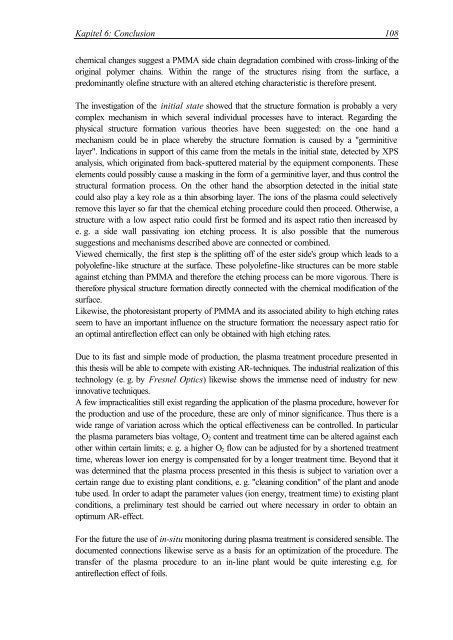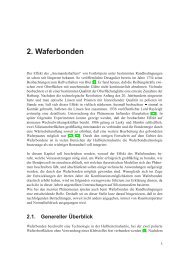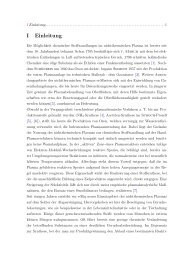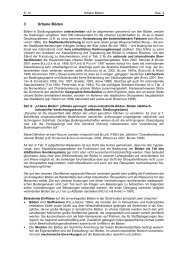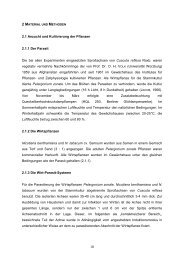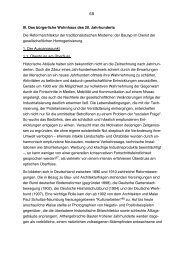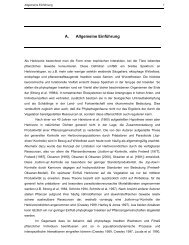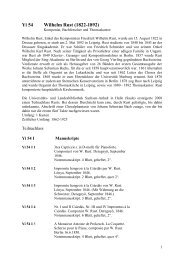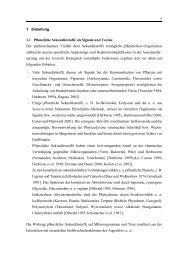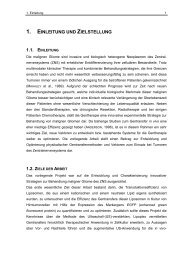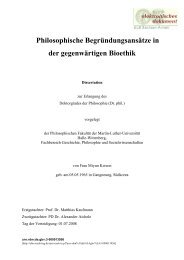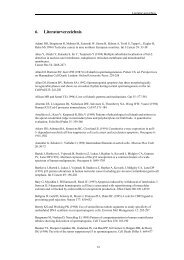Oberflächenmodifizierung von Polymethylmethacrylat durch ...
Oberflächenmodifizierung von Polymethylmethacrylat durch ...
Oberflächenmodifizierung von Polymethylmethacrylat durch ...
Erfolgreiche ePaper selbst erstellen
Machen Sie aus Ihren PDF Publikationen ein blätterbares Flipbook mit unserer einzigartigen Google optimierten e-Paper Software.
Kapitel 6: Conclusion 108<br />
chemical changes suggest a PMMA side chain degradation combined with cross-linking of the<br />
original polymer chains. Within the range of the structures rising from the surface, a<br />
predominantly olefine structure with an altered etching characteristic is therefore present.<br />
The investigation of the initial state showed that the structure formation is probably a very<br />
complex mechanism in which several individual processes have to interact. Regarding the<br />
physical structure formation various theories have been suggested: on the one hand a<br />
mechanism could be in place whereby the structure formation is caused by a "germinitive<br />
layer". Indications in support of this came from the metals in the initial state, detected by XPS<br />
analysis, which originated from back-sputtered material by the equipment components. These<br />
elements could possibly cause a masking in the form of a germinitive layer, and thus control the<br />
structural formation process. On the other hand the absorption detected in the initial state<br />
could also play a key role as a thin absorbing layer. The ions of the plasma could selectively<br />
remove this layer so far that the chemical etching procedure could then proceed. Otherwise, a<br />
structure with a low aspect ratio could first be formed and its aspect ratio then increased by<br />
e. g. a side wall passivating ion etching process. It is also possible that the numerous<br />
suggestions and mechanisms described above are connected or combined.<br />
Viewed chemically, the first step is the splitting off of the ester side's group which leads to a<br />
polyolefine-like structure at the surface. These polyolefine-like structures can be more stable<br />
against etching than PMMA and therefore the etching process can be more vigorous. There is<br />
therefore physical structure formation directly connected with the chemical modification of the<br />
surface.<br />
Likewise, the photoresistant property of PMMA and its associated ability to high etching rates<br />
seem to have an important influence on the structure formation: the necessary aspect ratio for<br />
an optimal antireflection effect can only be obtained with high etching rates.<br />
Due to its fast and simple mode of production, the plasma treatment procedure presented in<br />
this thesis will be able to compete with existing AR-techniques. The industrial realization of this<br />
technology (e. g. by Fresnel Optics) likewise shows the immense need of industry for new<br />
innovative techniques.<br />
A few impracticalities still exist regarding the application of the plasma procedure, however for<br />
the production and use of the procedure, these are only of minor significance. Thus there is a<br />
wide range of variation across which the optical effectiveness can be controlled. In particular<br />
the plasma parameters bias voltage, O2 content and treatment time can be altered against each<br />
other within certain limits; e. g. a higher O2 flow can be adjusted for by a shortened treatment<br />
time, whereas lower ion energy is compensated for by a longer treatment time. Beyond that it<br />
was determined that the plasma process presented in this thesis is subject to variation over a<br />
certain range due to existing plant conditions, e. g. "cleaning condition" of the plant and anode<br />
tube used. In order to adapt the parameter values (ion energy, treatment time) to existing plant<br />
conditions, a preliminary test should be carried out where necessary in order to obtain an<br />
optimum AR-effect.<br />
For the future the use of in-situ monitoring during plasma treatment is considered sensible. The<br />
documented connections likewise serve as a basis for an optimization of the procedure. The<br />
transfer of the plasma procedure to an in-line plant would be quite interesting e.g. for<br />
antireflection effect of foils.


